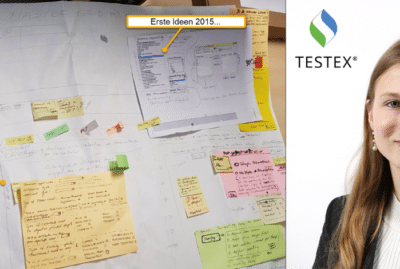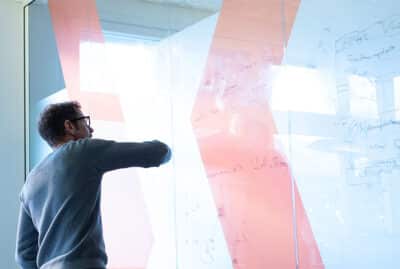Is your business software getting on in years and causing more problems than solutions? Outdated software can become a growing burden for companies. Is your software too slow, has security gaps and can no longer keep up with modern technologies and the growth of your company? This is a solvable problem. At soxes AG, we understand that not everything has to be redone from scratch. With proven methods such as re-factoring or re-engineering, we can already successfully overcome many challenges.
How do I update my outdated business software?

Which modernisation suits me?
Depending on the company’s situation, budget and the current status of your business software, it must be decided individually whether re-engineering or re-factoring makes more sense. We work with you to analyse the specific needs of your software and find individual solutions. It is important to us that improvements are made quickly without neglecting quality and security. Our KUBE-X development platform provides a stable and innovative basis for reacting quickly and effectively to the requirements of your software while always keeping security in mind. Thanks to the Slice & Dice process, KUBE-X can now also be used to modernise existing applications in just 4 steps, without BIG BANG!
Once complicated and time-consuming processes can be established in just a few steps. This saves our developers weeks of work, which they can invest in the development of customised components. This guarantees the customer the ultimate in quality assurance. Thanks to KUBE-X, re-factoring and re-engineering processes can be planned and implemented in a standardised, highly automated manner that is simple, traceable, fast, secure and efficient. Without any loss of quality.
The advantages of software modernisation with KUBE-X

Challenges with outdated software
Your software should support your business, but outdated systems often lead to slow operation, unforeseen failures and can’t keep up with new requirements. If you’ve noticed these signs, then it’s time for a re-factoring or complete re-engineering of your business software:
- Regular failures or errors: frequent system failures or error messages are a warning sign that the software has become vulnerable.
- Difficulties integrating new tools: If it is difficult to integrate new applications or tools into the existing software, this may indicate incompatibility and outdated technologies.
- Poor performance compared to modern solutions: If your software is slower or less functional compared to current solutions, it could be a sign that an update is needed.
- Complexity and confusion: If the software architecture or design has become confusing, it is difficult to make changes. It also makes troubleshooting more difficult.
- Outdated user interface: An outdated or inflexible user interface can impair user-friendliness and make it difficult to meet the requirements of modern workflows.
- Lack of support: If the manufacturer or developer has stopped supporting or developing the software and there are no more regular updates or patches, this can lead to security risks and functional problems.
- High maintenance costs: If the maintenance costs for maintaining the old software increase and a large part of the budget is spent on bug fixing, an update could be more economical.
- Feedback from employees or customers: If employees or customers frequently express problems or complaints about the existing software, this is a clear indication that improvements are needed.
Is your business software secure enough?
Do you want to review your customised software and uncover potential risks?
We analyse and evaluate your existing application code, uncover possible security gaps and protect your sensitive data!
Competent. Uncomplicated. Secure.

What is Re-Factoring?
Re-factoring focuses on improving the internal code quality of software without changing its external behaviour. It involves restructuring the code to make it more readable, maintainable and efficient without modifying the basic functionality. This process is often done incrementally, making small adjustments to improve the code – without a BIG BANG.
By re-factoring, you can extend the life of your software, reduce future maintenance costs and shorten the development time for new features.
If you’re wondering which approach is right for your organisation, consider your priorities and goals. Is your software severely outdated and in need of a major modernisation? Or do you only need improvements in the code to increase maintainability?
An example from practice
SolExperts AG commissioned soxes to develop a more intuitive UI for its application in order to offer it as stand-alone software. The software was first analysed, and due to a lack of documentation and high complexity, extensive refactoring was carried out. The creation of a clear specification provided a deeper insight and the new UI design resulted in a user-friendly application. You can find the complete project description here!
What is Re-Engineering?
In contrast, re-engineering refers to a more comprehensive approach that aims to make in-depth changes to the software in order to modernise or adapt it, which may also affect the external functionality.
Re-engineering is like a complete rebuild of your software. Re-engineering often involves redesigning the software architecture, migrating to a new platform, integrating new technologies or switching to a new system to improve performance, security and adaptability.
By re-engineering, you can future-proof your software so that it is based on the latest technologies, runs faster and more securely and is easier to adapt to new requirements.
If security vulnerabilities, slow performance or incompatibility with new technologies are your main problems, re-engineering might be the best solution. On the other hand, if you want to improve internal code quality and increase development efficiency, re-factoring may be a more suitable option.
Re-engineering in the public service
The diocese of St. Gallen is one of six dioceses in Switzerland. The personal data of the Diocese of St. Gallen was previously managed in a simple access application. As part of this project, soxes was commissioned to create a software solution with which the data of internal, external and freelance employees can be recorded and managed in a user-friendly manner.
soxes has developed a new web-based solution for this, which is based on ASP.NET and Java Script. Thanks to the new application, easier, faster and more sustainable use of personnel data within the Diocese of St. Gallen is possible. Find out more about this Access modernization worth reading.
Contact
Do you have any questions? Would you like to find out more about our services?
We look forward to your enquiry.
Contact us




































































